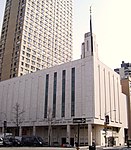St. Nicholas Rink

The St. Nicholas Rink, also called the St. Nicholas Arena, was an indoor ice rink, and later a boxing arena in New York City from 1896 until 1962. The rink was one of the earliest indoor ice rinks made of mechanically frozen ice in North America (others included the North Avenue Ice Palace in Baltimore and the Ice Palace in New York, both opened in 1894), enabling a longer season for skating sports. It was demolished in the 1980s. As a rink, it was used for pleasure skating, and the sports of ice hockey and skating. It was an important rink in the development of both sports in the United States. As a boxing arena, it was one of the first legal venues for boxing and remained a busy venue until its closing, although as the popularity of boxing grew, the sport outgrew the capacity of the arena to hold title fights. The arena hosted live boxing on television.
Excerpt from the Wikipedia article St. Nicholas Rink (License: CC BY-SA 3.0, Authors, Images).St. Nicholas Rink
West 66th Street, New York Manhattan
Geographical coordinates (GPS) Address Nearby Places Show on map
Geographical coordinates (GPS)
| Latitude | Longitude |
|---|---|
| N 40.773244444444 ° | E -73.980366666667 ° |
Address
WABC & ABC Headquarters
West 66th Street 77
10023 New York, Manhattan
New York, United States
Open on Google Maps








